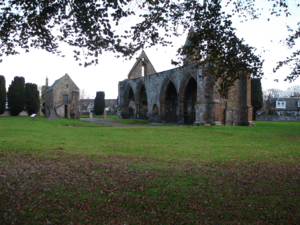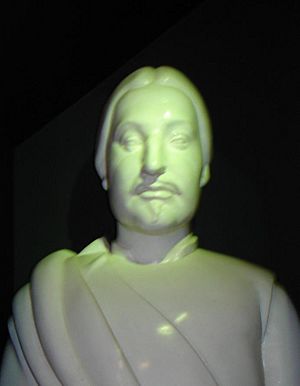Thomas de Dundee facts for kids
Quick facts for kids Thomas de Dundee |
|
|---|---|
| Bishop of Ross | |
| Church | Roman Catholic Church |
| See | Diocese of Ross |
| In Office | 1293 × 1295–1325 |
| Predecessor | Robert de Fyvie / Adam de Darlington |
| Successor | Roger |
| Orders | |
| Consecration | 18 November 1295 × 2 January 1296 |
| Personal details | |
| Born | unknown unknown |
| Died | 5 January × 17 April 1325 |
| Previous post | Subdean of Glasgow (1273 × 1293–1293 × 1295) Dean of Brechin (1293 × 1295–1295) |
Thomas de Dundee, also known as Thomas Nicholay, was an important Scottish church leader. He served as the Bishop of Ross during a tough time in Scotland's history. This was the period of the First War of Scottish Independence.
Thomas came from a well-known family in Dundee. He studied at the University of Bologna in Italy. After his studies, he began a career in the church.
He held positions in different church areas, including Glasgow, Brechin, and Ross. He even worked as a chaplain for a powerful cardinal. In 1295, the Pope chose him to become the Bishop of Ross. He held this important role until he passed away in early 1325.
Contents
Biography
Family and Education
Thomas was the son of a wealthy businessman from Dundee named Nicholas. His family was successful enough to send him to study at the famous University of Bologna in Italy. Thomas earned a "Master's degree" there in 1286.
He likely studied alongside other people from Dundee. One of them was Radulf de Dundee. This shows that his family valued education highly.
Early Church Career
Before becoming a bishop, Thomas held several church jobs. In 1293, he was the Subdean of Glasgow Cathedral. This meant he was a senior leader in the cathedral. He sometimes acted as a representative for the church leaders in Glasgow.
He was also known as Thomas Nicholay, which means "Thomas, son of Nicholas." This name was used when he helped inspect important documents for another bishop.
By 1295, Thomas was working at the Pope's court. He was a chaplain and companion to Cardinal Hugh Aycelin. This cardinal was a very influential figure. Thomas's legal training was likely very useful to the cardinal. Around this time, Thomas also became the Dean of Brechin Cathedral.
Becoming Bishop of Ross

The church leaders in Ross needed a new bishop. They held elections to choose a successor to the previous bishop, Robert de Fyvie. Two people were chosen: Adam de Darlington and Thomas de Dundee. Thomas already held a position as a church official in the Ross area.
Both Adam and Thomas gave up their claims to the bishop role. However, Cardinal Hugh Aycelin used his influence. He helped Thomas get chosen by the Pope on November 18, 1295. This way of choosing a bishop by the Pope is called "papal provision." Adam de Darlington later became the Bishop of Caithness as a way of thanks.
There was a delay of about two years before Thomas could fully take on his new role. This was because of political problems in Scotland. King John de Balliol was fighting with the King of England, Edward I of England. King Edward removed King John from power in 1296.
Finally, in July 1297, King Edward I allowed Thomas to take control of the bishopric. This meant Thomas gained the lands and income that came with being a bishop. Thomas had to meet with King Edward in London. He also had to promise loyalty to the English king. After this, King Edward ordered his official, John de Warrene, to help Thomas take his place as bishop.
Leading the Diocese

By August 1298, Bishop Thomas was in Scotland and active in his diocese. His official seal was used on a document about losses suffered by Scone Abbey. This happened after the Scottish rebels lost to the English at the Battle of Falkirk.
In the early 1300s, Thomas worked with Robert Wishart, the Bishop of Glasgow. Bishop Wishart was known for opposing the English king. Thomas also witnessed a document from John de Soules. Soules was acting as a temporary ruler of Scotland for King John Balliol.
After England gained more power in Scotland in 1304, Bishop Thomas worked with King Edward's officials. In 1305, King Edward even included Bishop Thomas in a group of advisors. This shows that King Edward trusted him.
Bishop Thomas seemed to support the English and King Balliol even after Robert de Brus became King of Scots in 1306. Thomas's views were similar to those of William II, Earl of Ross. In 1307, King Edward II of England asked Bishop Thomas for his support against King Robert.
However, King Robert's power grew stronger in Scotland. In December 1307, King Robert gained the loyalty of Earl William of Ross. After this, Bishop Thomas helped guarantee Earl William's future loyalty.
There are not many records of Bishop Thomas's activities in the years that followed. He was not specifically named as attending the Scottish parliament in 1309. This parliament was where many Scottish church leaders declared their support for King Robert. However, he was definitely present at the parliament held at Scone in December 1318.
In 1312, he put his seal on a peace treaty between King Robert and the King of Norway. In 1317, the Pope gave Thomas permission to approve a marriage. This was between King Robert's brother, Edward de Brus, and a daughter of Earl William of Ross. In 1321, Thomas helped arrange the repayment of a loan for Radulf de Dundee.
Bishop Thomas's last known activity involved a disagreement with Kinloss Abbey. This was about a church in Avoch that was part of his diocese. The Abbot of Kinloss claimed the right to control it. The Pope asked a church official to settle the dispute in January 1325. Bishop Thomas was likely alive then. However, he died by April 17, 1325. After his death, Roger became the new Bishop of Ross.

